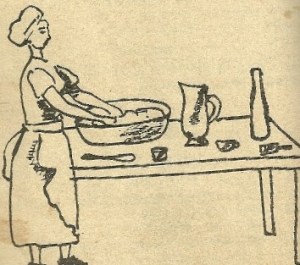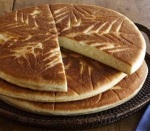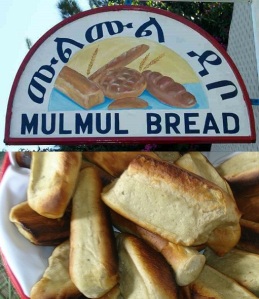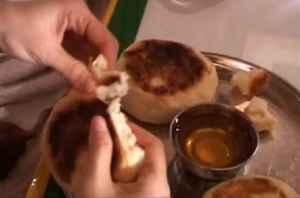EVERY NOW AND THEN, at an Ethiopian restaurant, my server will ask me if I need more “bread.”
She means injera, and of course, she’s not wrong to call it that. But in my mind, injera is injera – flat, spongy, bubbly on top – and bread is something else altogether.
Ethiopians do bake a variety of leavened breads, serving them on special occasions and holidays. They’re easy enough to make, and they’re a nice way to complement an Ethiopian meal with something a little different.
Dabo is the generic Amharic word for “bread,” and the book Ethiopian Traditional Recipes, published in 1980 by the Ethiopian Nutrition Institute, has a section of bread recipes along with some information on the role of leavened breads in the culture.
“The dabo is a very symbolic food and is used for many ceremonial occasions,” the book says. On the holiday called buhie, which occurs on Aug. 19, parents light torches and serve dabo to their children and other relatives, and the children sing the buhie song. Dabo also “symbolizes the chastity of a bride in some regions and is used during weddings. It is exchanged as a gift among in-laws and other relations during holidays. With all of these uses,” the introduction concludes, “it is no wonder that baking good bread is very important to a housewife, and her homemaking ability is often judged by the quality of bread she bakes.”
The book then shares its first recipe, for a bread called gogo, and it couldn’t be simpler: sifted barley flour, salt and water, blended and heated for about 20 minutes on a mitad, the large round device used for making injera. Most of the other breads are what the book calls “fermented,” which simply means that you add yeast to the moist dough and let it rise for a few hours, or in some cases overnight.
In Ethiopia, injera is the go-to bread, eaten at every meal by people who can afford the grain to make it. But cultures in some regions make more non-injera bread than other regions, and this exacerbates a growing environmental problem in Ethiopia.
The country is being deforested at a dangerous rate because of the need for firewood to fuel traditional ovens used for making injera and other breads. In regions that primarily eat injera, households use about 400 kilograms (880 pounds) of firewood a year, but families in regions (like Kafa) that make more “local breads” use 667 kilograms (1,445 pounds) of firewood a year, according to a 2014 study. Several international agencies are working to create and distribute more fuel-efficient stoves in Ethiopia and other countries facing this kind of deforestation.
Nonetheless, the tradition of baking leavened breads continues in Ethiopia and certainly always will.
Here’s a concise look at some of the most common Ethiopian breads that aren’t injera. The website How To Cook Great Ethiopian has posted a lot of bread-making videos that are generally easy to follow – once you convert grams of flour into cups of flour at this website. I’ll include links to those videos in the descriptions that follow. The site also has a brief guide to various Ethiopian breads.
♦ Dabo. This is the Amharic word for bread, a generic word to describe any type of leavened bread – that is, anything other than injera. Ethiopians will bake these breads in an over or on a mitad. (Watch a video of how to make dabo.)
Ethiopians make many versions of the basic dabo. For example, is it still “bread” if you use chick pea flour? That’s called shimbra dabo. There’s also a basic dabo made with onions, and another variety made with honey. And who doesn’t love muz dabo, an Ethiopian version of banana bread, although it truly is a bread, and not the more cake-like variety we eat here.
Some types of dabo are a meal in a loaf. There’s doro dabo – a favorite of Empress Taytu, the wife of the legendary Emperor Menelik II – made with chicken. You can also make a meaty bread using siga (beef) or asa (fish): ye’meter siga dabo, for example, is made with slices or cubes of beef. (The links on these names will take you to videos where you can see them being prepared.)
Amharic cookbooks from Ethiopia usually have many recipes for dabo and its variations. In 1964, an Ethiopian princess, Tsege Mariam Gabrerafael, published Ye’natochachin Moya – meaning “Mother’s Profession,” or “The Know-How of Our Mothers” – that includes recipes for egg bread, milk bread, Tigray bread (that is, bread from Ethiopia’s northern Tigray region), and ye’chemeqosh dabo, a wheat bread made by soaking the wheat flour overnight in water and letting it ferment before straining it and using it to bake the bread (the name of the bread refers to extracting liquid from something).
Genet Atinafu’s 1963 Ethiopian cookbook Ye’Bet Mesenado Bemelkam Zede, which means “home preparation with good methods,” has a recipe for ye’buna dabo, which means “coffee bread.” But there’s no coffee in the recipe, so it’s probably a bread that you eat with coffee. A recipe for ye’kerefud dabo, which means, more or less, “hard bread,” most likely should be ye’krenfud dabo, a bread spiced with cloves. The book also has recipes for ye’birtukan (orange) bread and zawater (“frequently”) bread, which may be a basic bread (wheat flour, yeast, salt, sugar, oil) that you make a lot.

Some finished loaves of defo dabo.
See the recipe here.
♦ Defo Dabo (sometimes written Difo Dabo). This is a variation of the basic dabo, but with a special feature: Before the baking begins, you wrap the dough in the big thick green koba kitel (enset leaf). The enset tree – sometimes called the false banana because it resembles a banana tree – is an important food source in numerous southern Ethiopian cultures. The trunk of the tree is ground into a meal, buried in the ground, and fermented into a “bread” called qocho.
A defo dabo is generally no more difficult to make than a regular dabo, but good luck finding the koba kitel that you need to wrap the bread. So in America, you can just use the leaves of he actual banana plant. Thai cooking sometimes uses them, so you can often find banana leaf (muz kitel) at a well-stocked Asian grocery store. It’s not quite the same as enset, but it’ll do in a pinch. I rarely, if ever, see koba kitel in Ethiopian markets.
As for the name, defo dabo, it’s a bit tricky. Dabo, of course, is bread, but my friend Menkir Tamrat, who makes Yamatt Tej, tells me that defo seems to derive from the Amharic verb tedefa, which means, among other things, to drop. To prepare your defo dabo for baking, you pour (i.e., drop) the dough onto a koba-lined mitad, then you cover it with more koba leaf. Next, you put another mitad on top so the dough is “sandwiched between two mitads during baking, like a giant Oreo cookie, or an upside-down cake.” Finally, the mitads are sealed with a mixture of clay and straw paste. I have a dictionary that also says the word tedefa means “to bake,” and that would make sense if it’s the origin of defo.
♦ Ambasha. This popular Ethiopian bread, which you’ll sometimes find at restaurants, comes to the national cuisine from northern Tigrinya-speaking regions. You’ll sometimes see it written hambasha, which is how it was spelled in Ge’ez, the ancient (now liturgical) language of Ethiopia.
It’s made pretty much like any dabo, although the shape is round and somewhat flat. Just before baking an ambasha, you use a knife to carve a symmetrical design in the top of the dough, so it looks a little like a wagon wheel when you place it in the oven. Then, when it’s done, you can smear the top with berbere and niter kibe. (Watch a video of how to make ambasha.)
♦ Hibist. This is the word for “bread” in Ge’ez, the ancient language of Aksum (early Ethiopia), and today in Amharic, it means “manna.” As a bread, it’s steamed and light. (Watch a video of how to make hibist.)
♦ Mulmul. This bread, when finished, looks a lot like an Italian bread, white and crusty. A good place to find one in Ethiopia might be at Mulmul Bakery, an Addis Ababa establishment (with two locations) that makes all kinds of breads and pastries, including cookies, donuts, muffins, Danish, baguettes, croissants, brioches and bread sticks. (Watch a video of how to make mulmul.)
♦ Dabo Kolo. This isn’t a bread, but it’s made from bread dough. Prepare the dough just as you would for a bread, then roll it into long strands, cut the strands up into pieces about the size of a fingernail, and fry them in oil (or bake them in an oven). You can then dust the cooked pieces with berbere if you like to make them spicy. If you cut them into thicker, larger pieces, you’ve made a variety called kaka, which one of my cookbooks describes as a “Somali biscuit.” Both varieties make a tasty (almost addictive) snack. (Watch a video of how to make dabo kolo.)
♦ Kita. Falling somewhere between a leavened bread and injera, a kita is something like an Ethiopian pizza crust. After you mix the flour and water, you put it on a hot surface and let it cook on both sides until it’s lightly browned and cooked through. You can then smear it with niter kibe (Ethiopian spiced butter) and berbere. If you break it up into little pieces, you call it chechebsa.
In their 2003 essay, Griddles, Ovens, and Agricultural Origins: An Ethnoarchaeological Study of Bread Baking in Highland Ethiopia, the scholars Diana Lyons and A. Catherine D’Andrea write mostly about baking injera. But they also briefly mention three other types of bread: the kita; the ambasha, “slightly leavened with beer and eaten in the fields”; and the habishti (that is, hibist), “a leavened wheat loaf particular to southern Tigray that is baked for harvest and Holy Days” – which seems like an appropriate use of manna.
But the authors also write this: “Other distinct bread types include hanza, tasfa, tadiq, and daboo. Although these were not observed in our study, they indicate the existence of a greater range of bread types for use in specific social and ritual contexts.”
They say no more about these breads, so I did some digging into the literature they cite:
♦ In 1868, the British explorer Mansfield Parkyns published Life in Abyssinia, his account of a trip to Ethiopia, and he writes about hanza, “a large cake more frequently met with in the lower provinces of Tigre,” a region in the north of Ethiopia.
Using millet or teff, Parkyns says, you take two pieces of injera and smear each with dilleh – that is, a paste made with berbere, the Ethiopian red pepper. “They are then stuck together by a layer of dough spread between them,” he writes, “and re-baked so as to form only one. This kind of cake is often given by the peasantry as a kind of present to richer neighbors.” The finished product sounds a little like anababero, made by piling pieces of injera on top of each other and soaking them with niter kibe and berbere.
♦ Daboo appears in volume three of William Harris’ massive multi-part tome Highlands of Ethiopia, published in 1844. This, of course, is the Amharic word for “bread,” and Harris lists various kinds. “Daboo is restricted to wealthier classes,” he writes, “but there are numerous other methods employed in the preparation of grain, descending through hebest, anababero, anabroot, deffo, amasa, debenia, demookta, and kita, the first four being composed of wheaten flour, and the remainder of teff, gram [chick peas] juwarree, barley and peas.” Some of these breads’ names should look familiar.
♦ Tasfa and tadiq come from Craven H. Walker’s 1933 book The Abyssinian at Home. The former means “hope,” and it’s “a wheaten bread which old women and nuns have baked at home on Saturday and bring to the priest to bless, a tiny bread to distribute among the poor and those who come to kiss the church.” The latter is “a wheaten loaf or barley bread or even bread of millet, though wheat is better, since it is the chief grain.” Priests will use a tadiq as a sort of communion bread, breaking it into pieces and serving it to travelers along with a drink of homemade beer. Walker also writes about the Aug. 19 holiday buhie, identifying a wheat bread of that name served on the holiday, as well as a bread called tibina, which mothers make in honor of their male children. And he observed that “pieces of bread may be baked doubled together, which is called anababero.”
ALTHOUGH SOME OF THESE BREADS from 19th Century literature aren’t commonly known today (if at all), most of the others are familiar across Ethiopia. But there are some breads particular to certain cultures in contemporary Ethiopia.
One favorite Oromo bread of the pastoralist southern Borana region – usually made with barley flour, and somewhat similar to an ambasha – is called chumbo, and the process of making it is somewhat elaborate. The cook begins by heating a concave mitad-like oven with hot coals. She places the dough or batter onto the hot surface, covers it with enset leaves, then places a second identical concave oven on top. The finished bread comes out moist and juicy.
The blogger Charish Badzinski wrote a squib about chumbo: “It’s made by pouring cheese (Ethiopian cheese has the consistency of cottage cheese and doesn’t taste like the hard cheeses we’re used to) and liquid butter mixed with berbere on top of flat circular bread.” It sounds like this is a finished chumbo spiced up with some special toppings.
Similar to this is the Borana mugera, another bread baked with a hot mitad on the top and bottom, with koba (enset leaf) wrapped around it. This is the Oromo version of a defo dabo, or mugera defach. But mugera has a special place in the Oromo diet. When a group of farmers from a community get together to help a neighbor with his harvest, they expect to be served mugera as a treat in the field at the end of the day’s work. If a child helps his neighbors by tending their cows or horses, he anticipates mugera when he completes his chores.
The making of chumbo and mugera are older country traditions, not practiced as much, if at all, by Oromos who live in cities. The Russian writer Alexander Bulatovich described these breads in his book about his travels through Ethiopia. “The leavened bread is spread out on an earthenware pan,” he wrote, “and from the top in the middle of a round loaf another smaller pan is squeezed. Fire is lighted under the large pan and on top of the small one. A somewhat heavy but tasty bread results.” He never names this bread, but he does mention “unleavened flat cakes” called kita.
In my Gurage cookbook, there’s a recipe for a cheesy bread: You combine ayib (Ethiopian cheese) with a prepared dabo, then add kibe, mitmita, cardamom and fenugreek. The recipe calls for more than twice as much ayib as dabo by weight, and almost as much kibe as dabo, so this will be a very rich concoction. A second version of the dabo doesn’t differ by much: a touch of salt and another blend of mitmita that’s not too different from the first. As for what kind of bread to use, it’s chef’s choice: I can find no recipe for a plain dabo in the book. But it might well be a defo dabo because of the importance of enset in Gurage culture.
In addition to injera, Ethiopian Jews would sometimes eat a leavened bread with sesame seeds on it, as well as using sesame seeds in other ways. But this was a custom of the Gondar region, where many Ethiopian Jews lived, and not a uniquely Jewish one. Because of fear and cultural taboos, Christians and Jews would rarely break injera together, even though their food was largely the same.
Ethiopian Jews celebrate the Sabbath with a special large loaf of bread called berekete, which the woman of the household bakes all night under an open flame on a hearth. She also lets buttermilk cook for a long time until it turns to cheese. After synagogue on Saturday morning, the family eats the bread, sometimes adding spicy berbere to the cheese and soaking the bread in it – much like chumbo in Oromo culture. There’s also tebugna, a small loaf of bread often served to guests with coffee, and engotcha, about the size of a biscuit, given to children. (You’ll find an engotcha recipe at the end of this post.)
Zenash Beyene, who owns Ras Dashen restaurant in Chicago, grew up Beta Israel in Ethiopia, and she still cherishes her memories of berekete. As we talked about those days, a Tigrayan Christian friend joined our conversation and wrote the word in Amharic. Zenash says that the Beta Israel and Tigrayan people are very close. “If you test his blood and my blood,” she says, pointing to her friend, “same thing.”
When the Passover holiday ends, the Beta Israel enjoy a celebration called Gdeft, ending eight days of eating matzos with a feast that includes engotcha dipped in honey, whose stickiness represents the closeness of family, and whose sweetness is a holiday treat. (A salty variety of engotcha is called dabeh.) The meal features generous servings of wot, alicha and t’ej, along with singing, dancing and prayers.
These are just some of the ways that Ethiopians make and use bread. There are surely others – some no doubt lost to history. In 1867, Henry Dufton published his Narrative of a Journey Through Ethiopia, and he writes about a “a very novel way of baking bread” – from the inside out.
The process begins by kindling a fire and placing some stone in the fire to heat. “The flour and water has meanwhile been kneaded into the consistency of dough capable of taking the shape of a cup,” he writes. “One of the hot pebbles is placed inside the cup and the dough rolled over it, so as to form a ball. In this shape it is placed in the ashes of the fire and well turned until the outside is baked; the heated stone serves to bake the inside.”
And that’s not the only usual bread-baking that Dufton saw.
“A hole is made in the sand,” he writes, describing another method. “A number of good-sized pebbles are placed in the hole, a fire is kindled on the top; when this has burnt down the red-hot embers are removed on one side and the liquid dough poured over the hot pebbles, the hot ashes are drawn over the upper surface, and the whole covered with earth; in a quarter of an hour all is removed, and discloses a large loaf or cake inside.”
And what did 19th Century Ethiopians eat with this primitive bread?
“Sometimes,” Dufton adds, “a whole sheep will be cooked in the same way.”
ADDENDUM
About a year and a half after I posted this piece, a reader wrote to ask me for an engotcha recipe. My Ethiopian cookbooks in Hebrew didn’t have any, but I dug around the internet and found one in Hebrew. Here’s a translation:
2 level cups of wheat flour
1 packet of yeast
3/4 cups water
1 tablespoon sugar
1 egg
1. Soak the yeast and sugar in 1/4 cup of warm water for 15 minutes.
2. Mix the egg with 1/2 cup water, then pour the mixture into the flour.
3. Mix well. At this point, the dough will be thick and clumpy.
4. Add the yeast mixture, moisten hands, and knead the dough well.
5. Cover the dough with a towel and let it rise for an hour.
6. Preheat oven to 300 degrees.
7. Roll out the dough when it has risen and form medium-sized pancakes (see photo above of engotcha). This much dough should make about five engotcha.
8. Arrange the patties on a greased baking pan and place in oven for about 30 minutes until golden.
Remember that you must serve the engotcha with honey for dipping.
Harry Kloman
University of Pittsburgh
An Ethiopian family says a prayer over a defo dabo:








Leave a comment